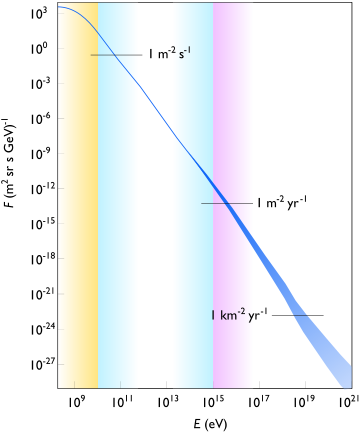RESEARCH: AN OVERVIEW
Plasma Astroparticle Physics ...
 |
| Cosmic flux versus particle energy. |
Plasma Astroparticle Physics is a rapidly growing field of research that connects particle physics, plasma and astrophysics.
It aims to answer questions such as:
- What is the Universe made of?
- What is Dark Matter and how can we detect it?
- What are Cosmic Rays? Where do they come from? What accelerates them? How do they propagate?
- What can gravitational waves tell us?
As the field of Plamsa Astroparticle Physics develops, it opens up new doors in astronomy. Nowadays light or, more generally, electromagnetic waves are not the only messengers from distant objects in the Universe, as we begin to observe very high-energy cosmic rays, neutrinos, or gravitational waves.
... in Bochum
In Bochum we mainly focus on the theoretical description of cosmic ray transport and interactions in the context of multimessenger data interpretation. We aim to explain the transport mechanisms directly at the accelerator . Here, diffusive transport at cosmic ray candidate sources like Active Galaxies, Supernova remnants and gamma-ray bursts are investigated, in particular concerning leptonic and hadronic interaction and radiation and their signatures at Earth. The transport of charged cosmic rays in the interstellar and intergalactic medium is modeled in semi-analytic and numeric models in order to understand the level of isotropy, the energy spectrum and composition of these atomic nuclei.
Collaborations
We collaborate with theoretical and experimental teams:
- CRPropa: CRPropa is a publicly available code to study the propagation of ultra-high energy cosmic rays (UHECRs) up to iron on their voyage through an extra galactic environment. By step-wise solving the equation of motion for the particle tracks, CRPropa can model the deflection in intergalactic magnetic fields, the propagation of secondary electromagnetic cascades and neutrinos for a multitude of scenarios for different source distributions and magnetic environments. It considers all relevant propagation effects like pion production, photodisintegration and energy losses by pair production of all relevant isotopes in the ambient low energy photon fields as well as nuclear decay. It enables the user to predict the spectra of UHECR (and of their secondaries), their composition and arrival direction distribution. In Bochum, the low energy extension of this code has been developed and released as CRPropa3.1. We use stochastic differential equations do solve the so-called Fokker-Planck transport equation which is a suitable description for the propagation processes of cosmic rays in the transition. This software will help to identify and describe sources of Galactic cosmic rays. Furthermore, it will contribute to the understanding of the mass outflows of external galaxies. We are continuing with this research by improving numerical methods of the code and by investigating cosmic ray propagation below the ankle.
- Cherenkov Telescopoe Array (CTA): the future system of Cherenkov telescopes will be covering an energy range between several tens of GeV up to above 10 TeV at a previously unknown sensitivity, about an order of magnitude better compared to the current generation of Imaging Air Cherenkov Telescopes. A large field of view up to 10 degrees will make a mapping of high-energy photon sources possible and a good resolution significantly smaller than 0.1 degree will enable detailed studies of extended sources. In Bochum, we are in particular involved in the calibration of the cameras for the Large Size Telescopes (LSTs) and in the investigation of the physics potential concerning the multimessenger ansatz for the search of hadronic components in galactic and extragalactic high-energy sources.
- IceCube: The IceCube Neutrino Observatory, completed in December 2010, is a Cherenkov detector deployed in the deep ice at the geographic South Pole. It consists of 5160 Digital Optical Modules (DOMs) attached to 86 strings, which are deployed in the glacial ice in Antarctica. It is the central goal is to investigate the emission of high-energy neutrinos from astrophysical sources. More than 50 highly energetic astrophysical neutrinos have been detected so far. The IceCube group in Bochum is contributing to connecting predictions of high-energy neutrino sources and experimental results, in particular by optimizing the analysis stragegies. The trigger rate in IceCube is dominated by muons created by cosmic ray interactions in the Earth's atmospher. It is one focus of the IceCube group in Bochum to investigate this atmospheric flux with different physics motivations:
(1) Moon and Sun block cosmic rays on their way to Earth and build so-called shadows. Such a shadow is visible in the IceCube muon data as well. The Moon shadow is used to investigate the angular resolution and pointing accuracy of the IceCube detector. It is expected to remain stable during a long term observation period. The intensity of the Sun's shadow, however, can vary, due to an influence of cosmic rays by the solar magnetic field near the Sun's surface. These variations thus yield an indirect view of the magnetic field structure near the solar surface.
(2) High-energy atmospheric muons measured with the IceCube Neutrino Observatory can yield information about the prompt contribution to atmospheric lepton fluxes. Relevant to studying the flux of astrophysical neutrinos, this also complements results from collider experiments in the forward region. In this work, a data sample dominated by high-energetic atmospheric muons in the energy range roughly between 3TeV and 300 TeV is isolated and analyzed in two ways. First, the differential energy spectrum of atmospheric muons is reconstructed. The best-fit power law index describing the atmospheric muon flux is found to be consistent with previous results. Second, dedicated simulations are used to show a proof-of-concept for reconstructing the effective Feynman-x of atmospheric muons by combining information from IceCube and IceTop. A robust correlation between true and reconstructed effective Feynman-x is found, enabling future studies of this quantity with the IceCube Neutrino Observatory.


